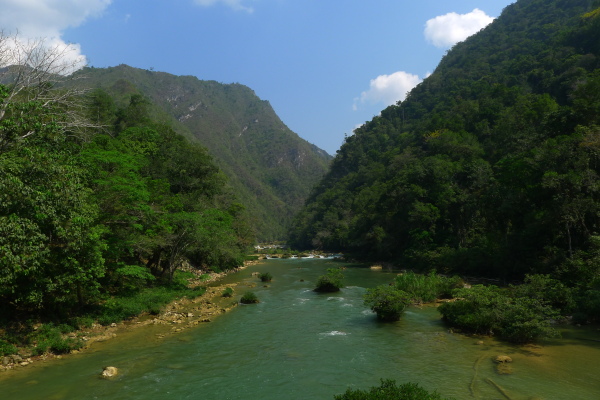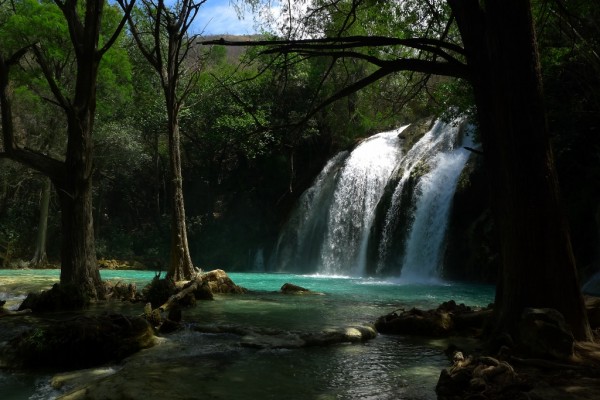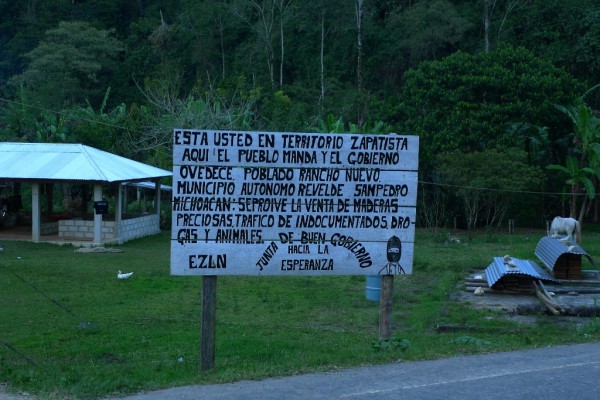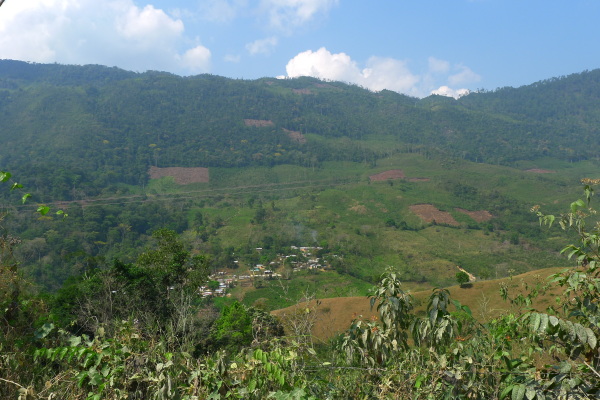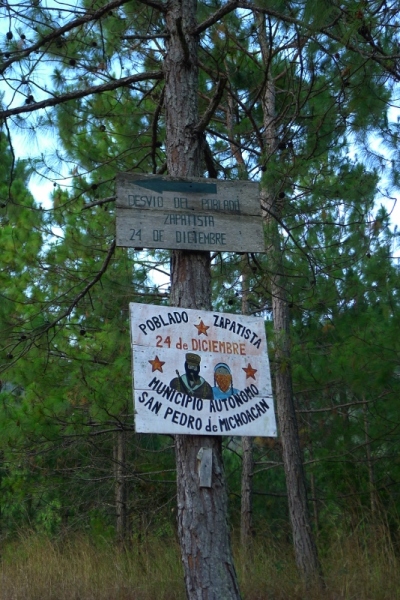San Cristobal
The famed Chiapas! Land of the Maya, the Zapatista, and the jungle; and the other favorite state of most Mexicans. Still sick from throat to gut, but on the road to recovery and excited to reunite with Phil and Jayne.
As a Russian, I was naturally drawn to learning about, and meeting, Zapatistas – a movement which seeks to return land to the natives, while building a community based government which is only loosely controlled by a centralized body. I bypassed the capital and came straight to the center of the Zapatista movement: San Cristobal de las Casas. Though not an official Caracol (Zapatista community/village), it is from where the ideas are brought to the rest of the world, and for those wishing to learn more about the movement the place to be. There are even some communities which are open to the public and to which a regular shuttle goes. Obviously I was not interested in anything like that, so I took it upon myself to ride deep into the jungle and meet the real Zapatistas.
I took a few days to enjoy San Cristobal, and spend some time with Phil and Jayne (the last for a very long time). A bit of sickness on their end slowed them down for a few days and I was able to catch up. San Cristobal is a place I have often since dreamed of coming back to. It is a lovely colonial town in the jungle skirted mountains of central Chiapas. The temperature is always cool, which makes me very happy. And it was the first place in Mexico I had found to have any coffee culture whatsoever. I was actually able to go to a few coffee shops and have a choice of the kind of bean I wanted and the manner in which it would be prepared. Granted it’s the high tourist contingency that provides this luxury, still, I’ve been in long need of a good cup so I cared little why or how I got it. But the best part was that San Cris is the kind of place a writer can get lost in – whether through wandering the cobbled streets, the colorful markets, or just sitting with a pen for countless months while gazing into the surrounding mountainous beauty from his window.
I took advantage of the few days rest I needed by camping at the gorgeous turquoise pools of, El Chiflon – one of the many waterfalls in Chiapas. Exotic butterflies of all shapes and colors circled around as though they were as common as flies, with the biggest butterfly I have ever seen outside a display case flying at incredible speed around me – it was the kind of radiant metallic blue that is so rare in nature you almost think it was painted that way. The ride to the waterfall gave me my first sense of Chiapas being another world altogether. Outside the two major cities of Tuxtla and San Cris, Chiapas reverts to the Mayan world. The faces are different than anywhere else in Mexico; the landscape is thick in jungle on one side, on the other the smell of pine perfumes the air; the languages and dialects are different from what I have heard before, as is the music and dress; and maybe it’s just my imagination, but there’s almost a smell of revolution in the air.
The next day I remounted my ailing Georgia, and ventured once again where white men don’t normally go, this time deep into the jungle in search of the elusive Zapatistas.
Zapatistas
From Comitan to Las Margueritas not much changes in the way of landscape or political affiliation, but beyond the Margueritas you are in Zapatista country. The land starts to get divided into family plots, as opposed to larger farms and the pueblos are small and simple, if a little poverty stricken. None have running water, some don’t have electricity – the ones that do, don’t have it for every house or building. The people are poor, but they all have their land, and have each other to help work it. They all grow a little bit of everything needed to sustain life: corn, beans, coffee, some livestock… but few fruits or vegetables other than the ubiquitous banana. The further south and east you go, the wilder the landscape becomes, until you find yourself in the middle of the jungle. Most villages are situated in forest clearings – at first tropical and pine, then pure jungle.
The road was twisty and slow – barely lit from the giant red ball of the sun peering over the upper reaches of the misty jungle peaks. I stopped to rest and talked to a tienda owner. He told me about San Jose del Rio – a Zapatista village down the road, . Though I was in a Zapatista village, it was clear that he did not want to deal with an outsider, so he sent me along. So I kept riding, stopping every now and again to just listen to the jungle. Sometimes there was pavement which brought me up to 3rd gear, at others I was happy to cruise along in 2nd. I generally don’t care about my speed, but the sun was quickly sinking behind the mountains, so when I reached San Jose del Rio, I pulled over to ask if there was a place I could stay, in my tent or otherwise. It is not normal practice to ask, let alone be allowed to stay in a Zapatista village. Normally a person would have to go through La Junta de Bien Govierno at La Realidad to gain permission to stay at one of the villages. But La Realidad was still far away, and this was not a road to ride at night.
Usually when I pass by villages I get stares or waves, but when I stopped at San Jose I got a crowd – clearly it was not normal for someone from the outside world to stop there. I asked to stay and speak with the Authority of the village. At first I was interviewed by some guy and woman for about 30 minutes, and only afterwards introduced to the Authority, who turned out to be a nice, 25 year old chap, with a wife and kid. The Junta picked him, he accepted, and now he is the link between his village and the heart of the Zapatistas.
At first he, and the people who interviewed me, were reluctant to let me stay, but they also did not want to send me out on a dark road which turned to dirt, and stayed that way for the next 120 kilometers. I was given a little spot behind the church where I was allowed to put up my tent (staying in a house was out of the question, in fact I wonder what would have happened if I did not have a tent). I was instructed to not go anywhere – no houses, no stores (of which there were 2), no walking around the village – if I wanted to go somewhere I would need an escort. I was told not to approach anyone to talk, but I was free to talk to people if they came up to me. It was also made pretty clear that I needed to leave first thing in the morning.
People were really nice to me (as is the rule in Mexico), and many came up to my tent, or to the table in the Authority’s mother’s house where I took my dinner and breakfast. I bought a bag of rice and bread to share, and brought out my jars of honey from Oaxaca. But I mostly ate what the mother had already made: delicious tortillas with beans for dinner, and coffee, tortillas and honey the next morning. It was weird to not be able to speak (or ask) freely, so I ended up learning little more than what I observed just by being there and passing through the many other Zapatista villages.
San Jose was situated in a small valley in the jungle of south-eastern Mexico. It was little more than some buildings and fences in a sea of lush green. At dusk the fireflies came out to add light to the music of the hundreds of bird and insect species surrounding the hills, which slowly died away with the last rays of the sun. It felt so peaceful. And then someone came by to tell me that the following day was the “village day” (dia de pueblo), so that night there would be a fiesta. So instead of falling asleep to the sounds of nature, I had to stuff earplugs in my ears to attempt to drown out the Banda music which played well into the night. Not at El Chiflon, not at San Jose, not even in the remoteness of Miramar was I been able to find solitude and silence. I wasn’t allowed to attend the party – for good reason I suppose, so instead I talked to the few people who came by my tent, put in the earplugs, took a Benadryl and prayed for sleep.
The following morning, after fresh picked, roasted, ground and prepared coffee, I took off for La Realidad in the hopes of actually speaking with someone in depth about the Zapatista movement and way of life. I was expecting something a little bigger, perhaps even a bit imposing, but La Realidad was little more than every other Zapatista village. After 2 hours of being questioned in depth about who I am, where I’m from, where I’m going, where I’ve been and what I want… and then waiting some more, I was told that no one would speak with me and I should carry on to Laguna Miramar (my next destination). I was very disappointed, but there was little I could do.
Here I was in the deepest point of Chiapas, and I couldn’t even remember what pavement looked like. Instead, a twisty road of sand and gravel – the color of limestone, with the ever shifting consistency of any single-track worth its name, was how I made my way deeper still into the jungle, in search peace and untouched natural beauty. At any point on the ride through the undulating hills and valleys of the jungle I had but to shot off my engine to become immersed in the sounds of the jungle. I did not need to hike for hours to isolate myself, the road literally cut through the jungle, so I was always in the middle of it. I couldn’t hear the various reptiles, but the primates, bugs and birds sure did sing a pretty, if sometimes deafening, tune.
I was not much more informed than before about the Zapatistas, but at least I was in the most beautiful part of an already beautiful country.
